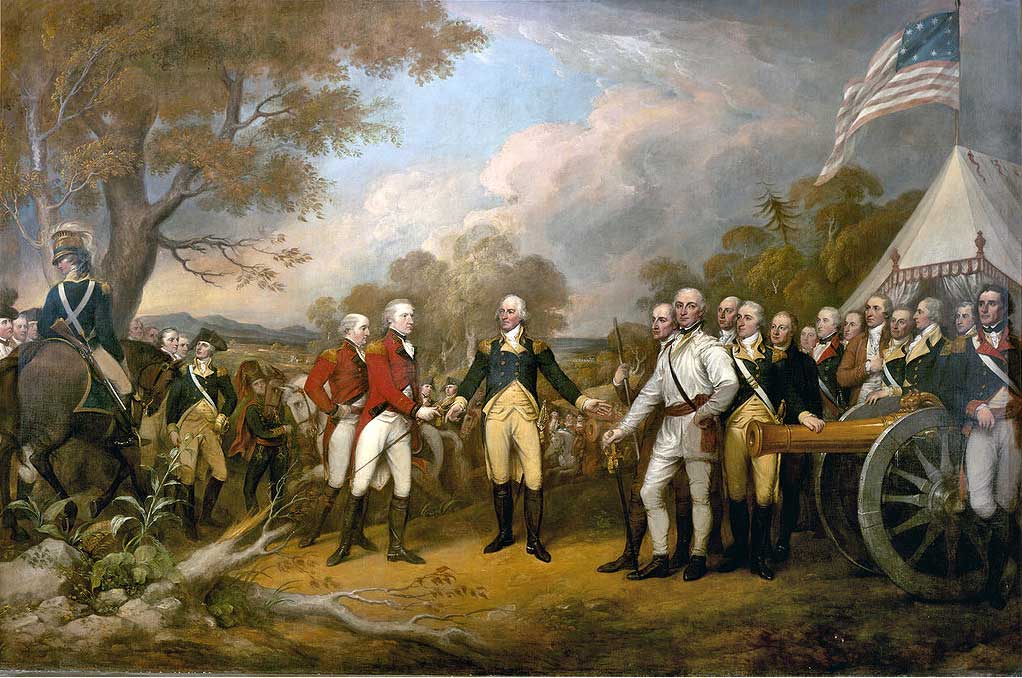Battle of Saratoga 1777

Burgoyne felt he had no option but to press on to Albany. The American army, however, was blocking his way at Bemis Heights. The British made two attempts to break through American defenses, but failed. After the second attempt, they withdrew to Saratoga, where they were surrounded by American troops. The British had no choice but to surrender which they did on October 13, 1777. One quarter of the British forces in North America thus surrendered, and, while many battles were yet to be fought, American Independence was assured.
.
Burgoyne continued southward, even as his options and support began to crumble. He crossed the Hudson on September 13th 1777 heading towards Albany. Burgoyne was down to 6,500 troops.
American General Gates was waiting for Burgoyne with 7,000 men. Gates was entrenched in Bemis Heights. The heights had been selected by his engineer, Thaddeus Kosciusko. They were anchored on the right by the Hudson, and on the left by a forest with steep bluffs. Burgoyne had no choice. If he wanted to make his way to Albany, then he had to take on Gage and his army.
Burgoyne sent 2,000 men, under General Fraser, on a flanking movement to the west, and then towards the American line. The main attack was to take place by General Hamilton's forces in the center. A third attack was to proceed straight down the river road. Burgoyne was handicapped by his limited knowledge of American positions.
Early in morning of the 19th of September 1777, the British troops set off. The Americans became aware of the British movements. At the insistence of Arnold, Gates agreed to send a force out from the fortification to determine British intentions. As a result, the battle developed at a clearing near Freeman's Farm. First, Morgan's riflemen ran into Fraser's left flank, cutting them down. The forces sent by Gates were, in turn, decimated by part of Hamilton's brigade. It went this way for most of the day, with piecemeal parts of the American and British forces being thrown at each other.
However, at the end of the day, the Americans still held the Heights. The British had lost 600 killed, and wounded or captured. Time was not on Burgoyne's side, with the nights getting longer and colder, food beginning to run low, and no option of local foraging. He had lost his Native American scouts, and the ranks of the American forces were swelling every day. Finally, in a desperate move to break out, Burgoyne sent 1,500 of his men on an attack on the western flank of the American forces. They were immediately attacked by Morgan's men, and a general British retreat soon ensued.
The Americans were not content with driving the British back. Soon a force under Arnold was attacking a section of the British defensive lines known as "the Horseshoe". After a fierce fight, the "Horseshoe" was captured. Burgoyne's position became untenable. That night, he pulled his forces back toward Saratoga. Burgoyne left behind his wounded and much of his supplies, after losing another 600 men. Once he arrived in Saratoga, it became clear Burgoyne would not be able to sustain his position. Gates had followed him, and soon had Burgoyne surrounded.
On October 12th, Burgoyne called a Council of War with his officers. The officers unanimously agreed there was no choice but to surrender. The next day, Burgoyne asked for terms, to which the parties agreed. Burgoyne surrendered. At this point, one quarter of the British troops in North America had been captured. The effects were far reaching, for the American victory had convinced the other European powers that an American victory was possible. As a result, aid was soon forthcoming.
 >
>